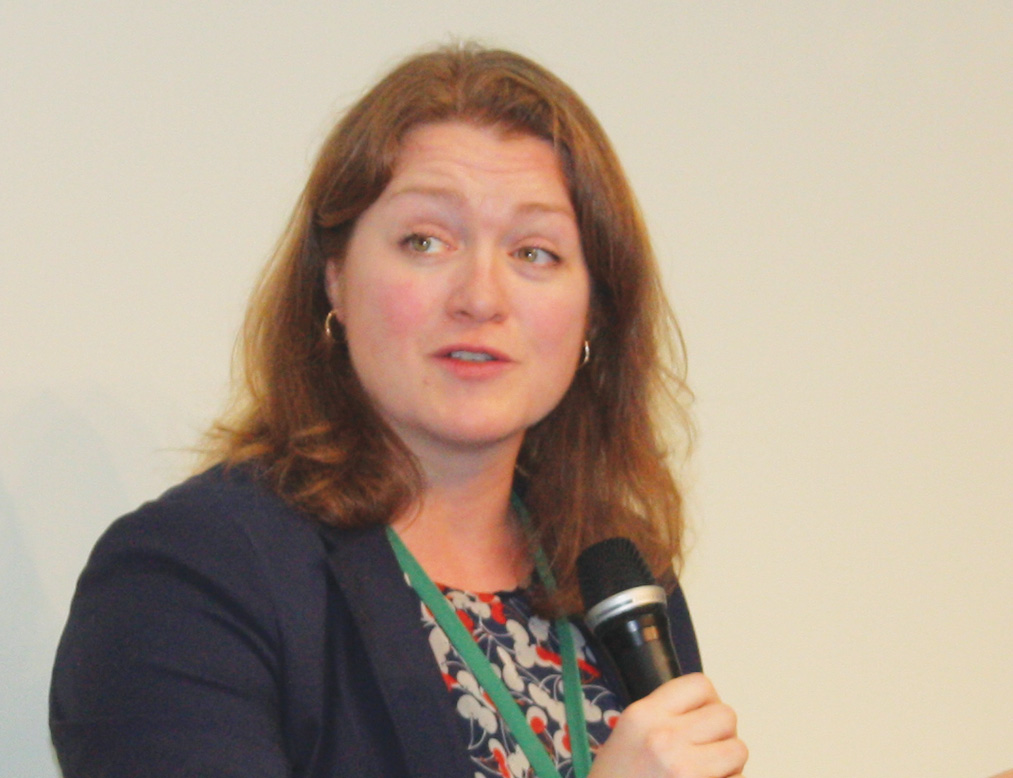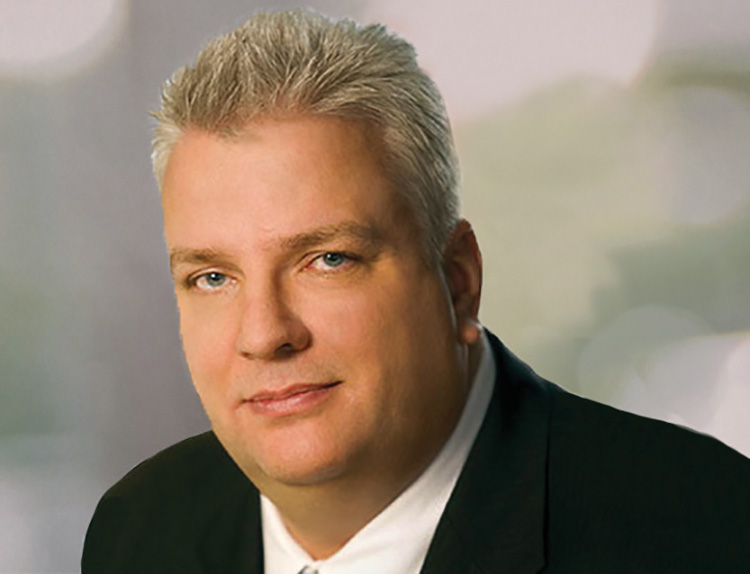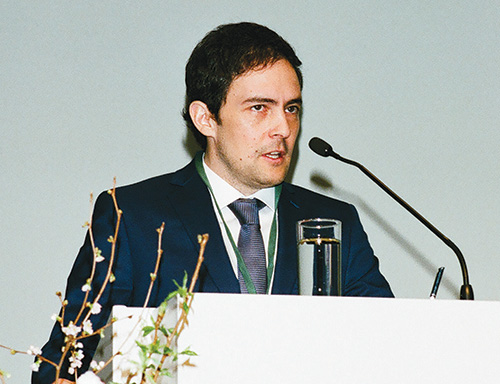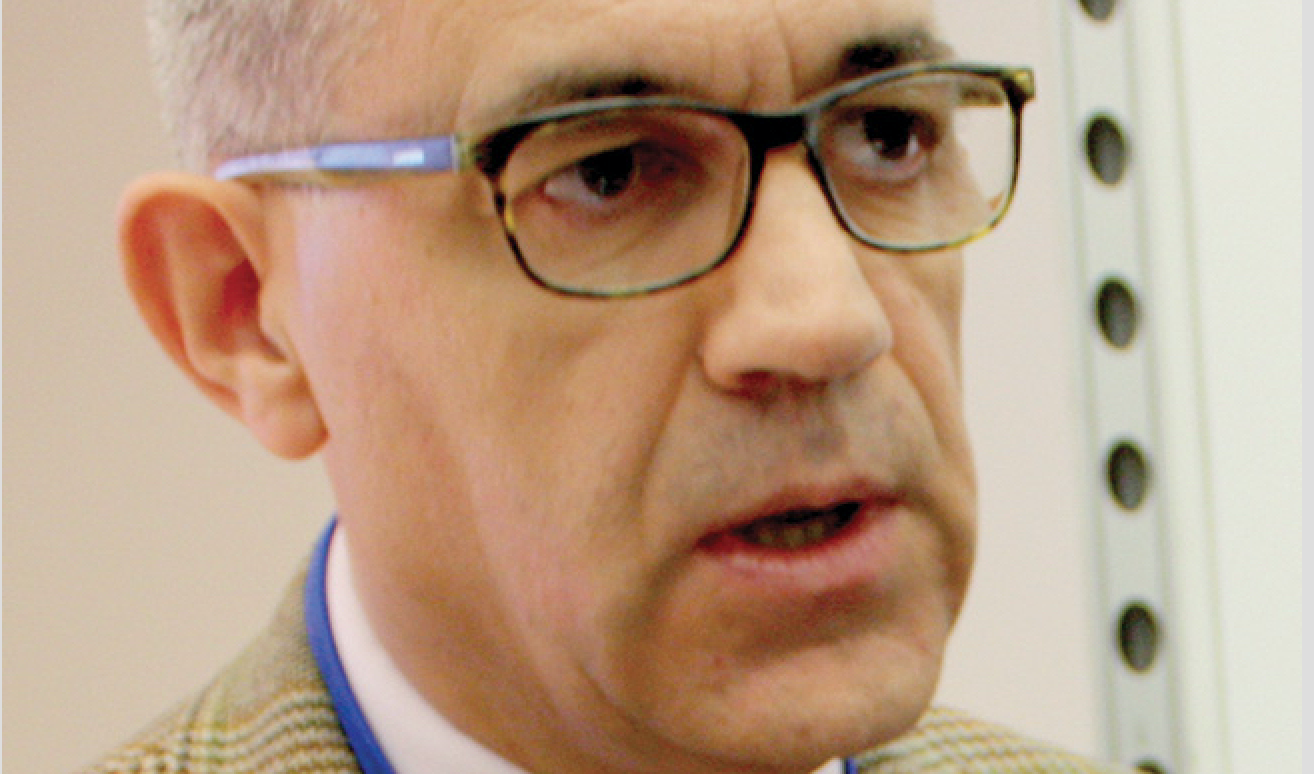This year’s Munich Satellite Navigation Summit featured pointed debates on high accuracy, integrity and authentication, exploring the trade-off between GNSS performance and security. And, as usual, there were some new products and systems looking to make a splash.
Among the hot topics in Munich was the role of GNSS in the burgeoning field of automated and unmanned systems. Michael Baus, Program Director at Robert Bosch GmbH, described his company’s fresh approach to precise point positioning (PPP) for autonomous road transport.
“Our new vehicle motion and positioning sensor (VMPS) will hit the road in 2020 and will be one of the first GNSS inertial positioning systems using correction data for highly automated driving,” he said.
“The VMPS will output a safe position, velocity, attitude and time, using a multi-frequency, multiconstellation GNSS system and our sophisticated fusion and integrity algorithms. The system will use wheel spin sensors as well as automotive-grade, safe inertial sensors to bridge GNSS outages.”
Yes, that’s right, he said “safe” two times. And then he said it again, this time with a “not”: “You all know GNSS alone cannot be safe; we cannot control the infrastructure. So, we are using a correction service consisting of a dense network of reference stations spaced about 250 kilometers apart, and we’re starting in Europe, North America, going to China, Japan, South Korea and the rest of the automotive countries.” Processing centers, he explained, will calculate orbit and atmosphere corrections.
Data is transmitted via geostationary satellites as well as over cloud connection to the vehicle, Baus explained, and the VMPS uses it to calculate the output signals and the all-important integrity information.
“We are working in partnership with Trimble for safe and precise positioning, and with u-blox for automotive safe positioning, and, together with Mitsubishi Electronics and Geo++, we are a stakeholder of the Sapcorda joint venture, whose target is worldwide safe and precise correction data.”
SBAS for All?
Another way to better and surer precision is through space-based augmentation systems (SBAS), such as the GPS Wide Area Augmentation System (WAAS) in the United States or EGNOS in Europe. These regional satellite systems provide GNSS correction data, giving increased accuracy and integrity for key “safety-of-life” applications, including civil aviation.
“Regions like the U.S., Europe, Russia or China may be able to afford to build their own SBAS systems,” said Miguel Romay, Executive Director of GNSS Aerospace at Madrid-based GMV, “but what if you are in a plane flying from Washington to Rio de Janeiro? In the U.S. you have SBAS, but in Brazil you don’t.”
Romay was in Munich to talk about GMV’s brand new “magic” user terminal, which uses SBAS capabilities onboard an Inmarsat GEO satellite already in orbit to provide GNSS correction over a wide area. “We thought there was a possibility to develop a company that provides SBAS services to different countries,” he said. “So, they don’t have to develop their own space-based system.
“We are cooperating with Lockheed Martin in the U.S., and we have a project in the Australia/New Zealand region where we are already transmitting through Inmarsat.” Specifically, GMV is providing the processing facilities in charge of the augmentation system, Lockheed Martin is doing GEO satellite signal uplink, and Inmarsat is responsible for the SBAS payload on the 4F1 satellite.
“Having multiple constellations allows us to move in the direction of a global, not regional, SBAS,” Romay said. “We have an operational test bed. All the infrastructure was completed in October of last year, and since then we have been testing it in different fields; maritime, aviation, mining.”
Romay showed us a “demo” receiver, the key components of which, he said, can actually fit inside a smartphone. “I believe this is the first dual-frequency, multi-constellation SBAS receiver, giving PPP with integrity. Using this in Australia, you can receive the signal through the SBAS satellite, and if you are outside Australia you use the internet to receive the SBAS and PPP corrections.”
GMV intends to offer two different products: a lower-cost, single-frequency, PPP receiver, equipped with the u-blox M8 chip and delivering 40-50 centimeter accuracy with integrity; and a higher-performance, NovAtelequipped receiver using GPS, Galileo and GLONASS and capable of achieving around 5 centimeter accuracy with integrity.
“Many people at this conference are talking about PPP with integrity,” Romay said, “so, here it is, we have a solution that we are ready to bring to market, and it can be integrated with other technologies and sensors.”

Galileo CS Reverberations
Things do appear to be moving on the PPP front. For its part, the European Commission (EC) continued in Munich to defend its recent decision to provide for free a high-accuracy GNSS service, originally conceived as one component of a Galileo fee-based commercial service (CS).
On the industrial side, where a number of companies have already developed and are delivering high-precision positioning for a fee, some wondered out loud whether the Commission’s move will undercut their own business. Of these, President of Hexagon Positioning Intelligence Michael Ritter was among the more outspoken. He expressed some confusion as to what “high-accuracy” actually means in the context of the new Galileo service.
“We’ve heard different definitions of what that is – 20 centimeter accuracy? Higher? What convergence time?” he asked. “Because what gives you 20 centimeter in one minute gives you one centimeter in five minutes, so there’s a lot of ambiguous vocabulary being used right at the moment.
Ritter pointed out that existing markets of survey, mapping, agriculture and offshore are already well served by existing European PPP and RTK correction networks and services, and that Hexagon Positioning Intelligence has been providing correction services for three decades. While industry is already working to solve the next challenges of GNSS correction services, he said, the provision of free services will remove or severely diminish the revenue source that industry relies on to reinvest in research and innovation for the autonomous future.
About the American companies in the room, he said, “Most of their employees working on PPP are actually in Europe as well. We all need that money to feed our R&D chain and that ’s why of course we are opposed to that free service.
“The reality is the only way we can get to the kind of functional safety and integrity we need, that kind of authentication, that kind of accuracy in a short time, which involves not a few but thousands and thousands of reference stations, we need to finance that, or we all sit back and wait 15 years for the government to do it. I’d prefer the EC and GSA would use these funds to speed up the Galileo authentication service.”

Commission Come-Back
In response, European Commission Galileo Commercial Service Manager Ignacio Fernandez-Hernandez said, “We believe that in the long term high accuracy is becoming cheaper and will eventually be free.” Hence, the Commission’s desire to get in front of this inevitable wave.
“Some are asking how Galileo high accuracy will affect the industry. But what we are proposing is not comparable to an end-to-end guaranteed service. What we intend to offer stays at the signal level. This relates only to providing better satellite information, better atmospheric information, which is what satnav providers have been doing for the last decade.”
Fernandez reminded participants of the steady trend towards increased accuracy even among open GNSS services available to the general public, and then he said, “You, the industry, are building partnerships and you are evolving your business models. With
Galileo high accuracy, maybe some existing services may not be as relevant as before, but there will be other new services.
“Our perception is that companies are ready to integrate high accuracy with other services, so there is still room
for innovation.”

Ritter returned to the question of what exactly Galileo intends to offer: “I don’t think the GSA [European GNSS Agency] has made any statement on what the convergence time is going to be, so 20 centimeters in 30 seconds? 20 centimeters in a much faster time? Between Trimble, Fugro, Deere and Hexagon and others, we invest a lot of money into fast convergence and high accuracy, so it’s actually an answer I would like to hear.”
“Just to be accurate, convergence is not a service that will be provided by Galileo,” Fernandez said. “Convergence depends on the user algorithms and the information that these algorithms process, so we are providing part of this information, but we are not investing in developing convergence algorithms or developing end-user solutions. These will 100% remain the business of companies providing high accuracy services.”
As for the stated 20 centimeter accuracy level, Fernandez revealed that that figure actually comes from a “higher level”, which we take to mean a more political level.
“We are talking about a very highlevel text,” he said, “which is a Commission ‘Decision’. We have this benchmark of 20 centimeters that expresses the willingness to relax accuracy compared to the service as it was originally defined as a payable service. This is in order to interfere less with existing markets and serve some end-consumer applications. But we are just at the start of the process of defining the service. The statistical characterization, the user environments, the baseline algorithms, all that is still to come.”
Authentic GNSS
While some participants were making a splash, others were offering cash. “If you have any brilliant ideas we have some funding for you,” said GSA Market Development Officer Reinhard Blasi. Then, having peaked everyone’s interest, he proceeded to discuss a number of other items of interest to the GSA, and to everyone else of course, such as market perspectives on authentication and the trend towards authentication as a priority for safetycritical applications.
For the Galileo program, authentication comes in or will come in three different forms. First, there is Open Service Navigation Message Authentication (OSNMA), which will provide a basic level of authentication and some anti-spoofing protection. Blasi said, “This signal will be disseminated over the E1 frequency and is available for singlefrequency users. It is aimed at consumer users and offered for free, already prototyped and under testing.”
A much higher level of authentication will be provided by the robust and secure, limited-access Galileo Public Regulated Service (PRS).
In between those two will be the “new” Galileo Commercial Service, comprising a data authentication signal that will be access-controlled and provided for a fee, based on the spreading code encryption of E6C plus some ancillary data in E6B/ E1B, including OSNMA.
Interesting to note is that even just within the services provided by one GNSS constellation, Galileo, there will be multiple authentication options available, with the choice falling to end users of determining their own vulnerabilities and security needs. But how, someone asked, will users know which level of protection they really need?

Authentic Corrections
Hexagon Positioning Intelligence Vice President of Innovation Sandy Kennedy said she sees military-like GNSS requirements, both in terms of accuracy and security, moving into commercial areas. “There is an increased risk to all established GNSS applications, and with new applications such as autonomous vehicles and verified location for financial transactions coming on quickly, pseudorange-based positioning is not sufficient. Authentic correction sources are now as important as authentic GNSS signals.”
We simply cannot defend against all kinds of attacks, Kennedy said, and those attacks will evolve. So GNSS providers will need to be vigilant, proactive and quickly reactive as new information presents.
To end-users, she said, “So, do you want a sports car or anarmored car? A person who decides to buy a sports car values certain things; they want the engine, they want the speed, the maneuverability. Somebody who has an armored car, it’s still a vehicle, but they value the security. They’ve probably given something up in terms of driving performance, but it’s because safety is their priority.”
It’s the same with GNSS receivers, she suggested. “Which of the parameters are most important for a particular user and why do they choose one or the other? We’ve heard about having a very quick time to first fix, when you drive out of a parking garage and want a solution instantly. Well you can get that but you’re going to have to wait some time before that’s an authenticated or verified solution – or you might not be able to run your RTK (real-time kinematic) solution at faster than 20 hertz, or we might not be able to track every single satellite in view, and so on.”
Are users ultimately going to have to choose a level of vulnerability they are willing to accept? “It really depends on your perception of risk,” Kennedy said. “What we are working on is what level of protection can be provided by default in the background without causing any compromises to performance. How much CPU (central processing unit) can we be using to run a bunch of interconstellation and intersignal checks and that sort of thing.
“Right now what we are seeing is customers that can articulate very clear needs in terms of accuracy levels in this many seconds, but we don’t have that kind of specific definition by customers in terms of interference detection.”
And why is that?, someone interjects. “I think people just don’t know.” Bingo. So there’s an education process that still needs to take place. Kennedy borrows from an old Canadian TV comedy sketch: “GNSS users, you need to know what you need to be afraid of!”
Money, Honey
But really, what about that funding? Between 2014 and 2020, the GSA’s Reinhard “The Candyman” Blasi said, altogether 111.5 million Euro (approximately $138 million) will have been invested by the GSA, at the behest of the EC. This is mainly for Horizon 2020 Fundamental Elements projects, aimed at developing the likes of EGNOS and Galileo-enabled chipsets, receivers and user terminals.
“We want to build on innovative services and differentiators,” he said, “while addressing real user needs and maximizing the benefits for EU citizens.”
One of the key stated aims of all H2020 funding has been to increase industrial competitiveness within the EU, which means the program prioritizes EU participation, but parties from third countries can get funding under certain conditions.
Upcoming 2018 and 2019 grants, not yet awarded, will go to projects aimed at developing Galileo-based timing receivers, CS user terminals and enhanced GNSS user terminals. So, there you have it. Any brilliant ideas? Look for Reinhard Blasi.






